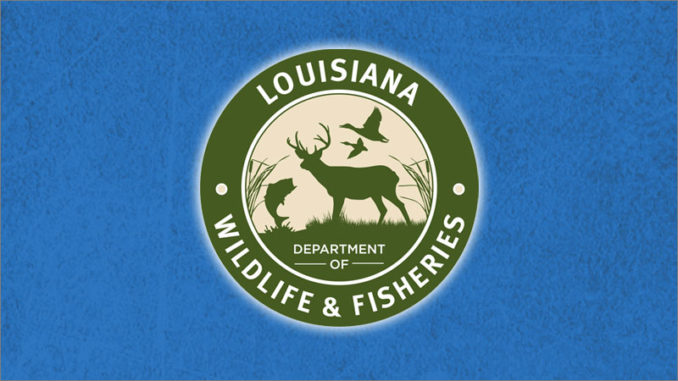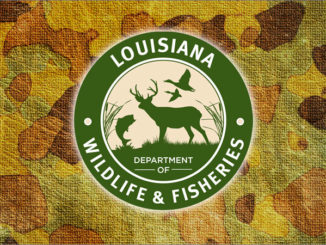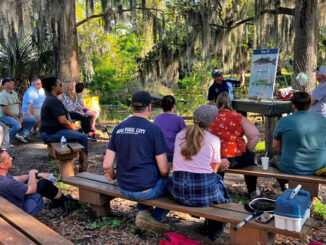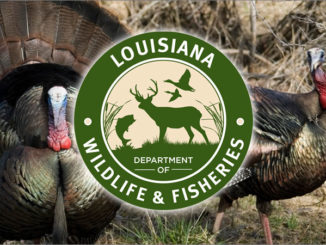
The Louisiana Department of Wildlife and Fisheries (LDWF) has scheduled a drawdown of Lake Bistineau in Webster, Bossier and Bienville parishes for the purpose of reducing the further expansion of giant salvinia. The drawdown will additionally benefit fisheries production by improving aquatic habitat and reducing the amount of organic matter on the lake bottom.
LDWF has requested the Department of Transportation and Development open the water control structure on July 25. Once the water control structure is open, the lake should dewater at a rate of 4 to 6 inches per day until it reaches a potential maximum drawdown level of 8 feet below pool stage. This dewater rate could be impacted, however, by local rainfall in the surrounding watershed. During the drawdown, the department will monitor aquatic habitat conditions to determine the best time to conclude the drawdown and allow the lake to refill for early spring recreational activities.
Below are some frequently asked questions and related information regarding the upcoming drawdown on Lake Bistineau.
Why are drawdowns used to manage giant salvinia on Lake Bistineau?
During the warmest parts of the summer, giant salvinia on Lake Bistineau can double its coverage in less than three days. As the accessible parts of the lake are sprayed and the dying salvinia sinks, the ever-growing salvinia mats in the forested areas of the lake continue to push out new plant material. Due to the rate of plant growth, it is extremely difficult to keep the plant coverage at manageable levels with only herbicide applications.
Drawdowns strand and kill the plant material that is actively growing and reproducing in the shallow areas of the lake, allowing the spray efforts to make greater strides in reducing salvinia coverage in areas that are accessible to boats.
Relying on herbicides alone during the peak summer growing season would also carry a very large price tag. It is more cost-effective to combine the benefits of a drawdown with herbicide applications to make better use of available public funds.
What factors do you consider when making a decision on a drawdown start date?
We consider multiple factors such as: the amount of acreage covered by salvinia, the amount of funding available to spray problematic areas, and the amount of public use occurring on the lake. We attempt to balance the need to control salvinia expansion through drawdowns with the desire by the public to use open areas of the lake during the summer. An early summer drawdown would provide the best salvinia control, but that would greatly impact use of the lake when the public desires it the most. Therefore, we attempt to delay the drawdown as long as we can.
Will boaters still be able to access the lake during the drawdown?
Yes. During the drawdown, more than 7,500 acres of water will remain in the lake. Boaters can still access the lake during the drawdown from the following public boat launches: Port of Bistineau Launch, Bossier Public Launch, Grice’s, and Bayou Dorcheat Public Launch. Boaters are advised to use caution during the low water period, as boat lanes will not provide normal clearance of underwater obstructions.
Why does the drawdown need to be in the summer rather than winter?
One of the ways a drawdown works to control salvinia is to dry out the plant and the water bottom. Giant salvinia is much more susceptible to drying during the summer than it is to freezing during the winter. Additionally, exposed water bottoms do not dry out nearly as well during the colder months (also some of the wetter months) of the year. If there is any moisture left in the soil, the giant salvinia will be able to survive. The extreme hot and dry conditions that we typically experience from June – September provide ample drying of the water bottom and desiccation of the plant material. Also, this is the fastest growing time of the year for giant salvinia. To have the lake at drawdown stage during this time provides less water surface for the remaining salvinia to reproduce and thrive. Lake Bistineau also has a very large watershed (draining nearly 1 million acres of land), which makes it difficult to remove water from the lake or keep the lake lower during the wet winter season.
I live on the southern part of the lake, where the giant salvinia doesn’t look too bad. Do we really need to have a drawdown if the lake is still usable down here?
Yes. The southern end of the lake contains more open-water habitat, which is less conducive to the growth of floating aquatic vegetation such as giant salvinia. Therefore, this portion of the lake will typically be the last area to experience problems. However, with an exponential growth rate of salvinia in July and August, plant material will soon begin to impact those open areas down the lake as well.
Are drawdowns designed to improve the condition of the lake now, or to prevent worse conditions next year?
Both. A drawdown provides immediate benefits by reducing the amount of giant salvinia coverage that currently exists on the lake. It is also a proactive management strategy used to ensure a better situation on the lake the following year.
Data from past years show a direct correlation between the number of acres of giant salvinia on the lake before a drawdown is initiated, and the amount that will be present as we approach the spring and summer of the next year. The longer we allow salvinia to grow on the lake prior to initiating a drawdown this summer, the more salvinia will be present next spring, and subsequently next summer. Herbicide application efforts and timing have been consistent over the years. Therefore, the reduction in giant salvinia annually can be mostly attributed to drawdown actions and their timing. We feel that it is critical to prevent salvinia from greatly expanding one year to prevent a worse situation next year.
Are there other benefits from a drawdown?
Yes. Drawdowns are beneficial to the fish population in flooded swamp lakes such as Lake Bistineau. Drawdowns expose the bottom of the lake to drying action, which helps to reduce the organic build-up such as dying salvinia, other vegetation and cypress tree leaf litter. Without drawdowns, this material continues to build up on the bottom, reducing and even preventing fish from spawning. Drawdowns offer opportunities to observe many unique species of wading birds that are attracted to the lake, result in increased fish catches during a time of year when fishing gets tougher on other area lakes, and gives shoreline property owners a chance to make repairs to docks and seawalls.
Is Lake Bistineau the only lake with the salvinia challenge?
No. LDWF Aquatic Plant Control Program is battling giant salvinia in more than 50 waterbodies around the state. Each waterbody is different, and all present a unique challenge in managing the nuisance aquatic weed.
With LDWF’s recent revenue increase, will Lake Bistineau be sprayed more often?
Possibly. The increase in revenue through the recently-enacted license fee restructure will provide more funding for control efforts on public water bodies statewide. However, there are several factors that we use to determine how much herbicide spraying is conducted on each – including the amount of plant material, its location on the lake and the availability of herbicide application contractors and equipment.


